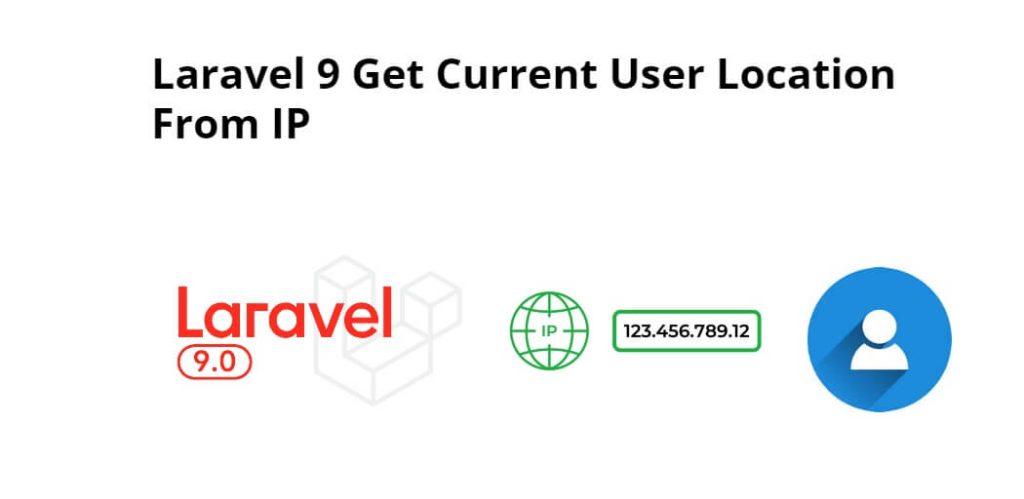Laravel 9 get current user location from ip; In this tutorial, we will learn how to get current user location from ip address using stevebauman location package in laravel 9 apps.
The stevebauman/location is an very useful library for detecting a users location by their IP Address, and It made retrieving a user’s location information from IP address exorbitantly effortless.
The complete list of location information that you are going to get based on IP address in laravel app with location library:
- Country name and code
- Region name and code
- City name
- Zipcode
- ISO code
- Postal code
- Latitude and longitude
- Metro code
Laravel 9 Get Current User Location From IP
Use the following steps to get current user location from ip address in laravel 9 apps:
- Step 1 – Download Laravel 9 Application
- Step 2 – Connecting App to Database
- Step 3 – Install stevebauman/location Package
- Step 4 – Create Route
- Step 5 – Create Controller By Artisan Command
- Step 6 – Create Blade View
- Step 7 – Run Development Server
Step 1 – Download Laravel 9 Application
First of all download or install laravel 9 new setups. So, open the terminal and type the following command to install new laravel 9 app into your machine:
composer create-project --prefer-dist laravel/laravel blog
Step 2 – Connecting App to Database
In this step, set up database with your downloaded/installed laravel 9 apps. So, you need to find .env file and setup database details as follows:
DB_CONNECTION=mysql DB_HOST=127.0.0.1 DB_PORT=3306 DB_DATABASE=database-name DB_USERNAME=database-user-name DB_PASSWORD=database-password
Step 3 – Install stevebauman/location Package
In this step, open again your command prompt and execute the following command on it. To install Install stevebauman/location Package
composer require stevebauman/location
After installing package we have to setup config file. So open config/app.php file and add service provider and alias.
'providers' => [ .... Stevebauman\Location\LocationServiceProvider::class, ], 'aliases' => [ .... 'Location' => 'Stevebauman\Location\Facades\Location', ]
Step 4 – Create Routes
In this step, open web.php file from routes direcotry. And update the following routes into web.php file:
<?php
use Illuminate\Support\Facades\Route;
use App\Http\Controllers\UserController;
/*
|--------------------------------------------------------------------------
| Web Routes
|--------------------------------------------------------------------------
|
| Here is where you can register web routes for your application. These
| routes are loaded by the RouteServiceProvider within a group which
| contains the "web" middleware group. Now create something great!
|
*/
Route::get('display-user', [UserController::class, 'index']);
Step 5 – Create Controller By Artisan Command
In this step, run the following command on command prompt to create controller file:
php artisan make:controller UserController
After that, go to app/http/controllers and open UserController.php file. And update the following code into it:
<?php
namespace App\Http\Controllers;
use Illuminate\Http\Request;
use Stevebauman\Location\Facades\Location;
class UserController extends Controller
{
/**
* Display a listing of the resource.
*
* @return \Illuminate\Http\Response
*/
public function index(Request $request)
{
/* $ip = $request->ip(); Dynamic IP address */
$ip = '162.159.24.227'; /* Static IP address */
$currentUserInfo = Location::get($ip);
return view('user', compact('currentUserInfo'));
}
}
Step 6 – Create Blade View
In this step, visit resources/views directory and create user.blade.php. Then add the following code into it:
<!DOCTYPE html>
<html>
<head>
<meta charset="utf-8">
<title></title>
<link href="https://cdn.jsdelivr.net/npm/[email protected]/dist/css/bootstrap.min.css" rel="stylesheet">
</head>
<body>
<div class="container">
<h1>How to Get Current User Location with Laravel 9 - Tutsmake.com</h1>
<div class="card">
<div class="card-body">
@if($currentUserInfo)
<h4>IP: {{ $currentUserInfo->ip }}</h4>
<h4>Country Name: {{ $currentUserInfo->countryName }}</h4>
<h4>Country Code: {{ $currentUserInfo->countryCode }}</h4>
<h4>Region Code: {{ $currentUserInfo->regionCode }}</h4>
<h4>Region Name: {{ $currentUserInfo->regionName }}</h4>
<h4>City Name: {{ $currentUserInfo->cityName }}</h4>
<h4>Zip Code: {{ $currentUserInfo->zipCode }}</h4>
<h4>Latitude: {{ $currentUserInfo->latitude }}</h4>
<h4>Longitude: {{ $currentUserInfo->longitude }}</h4>
@endif
</div>
</div>
</div>
</body>
</html>
Step 7 – Run Development Server
Finally, open a command prompt and run the following command to start the development server:
php artisan serve
Then open your browser and hit the following URL on it:
http://127.0.0.1:8000/send-sms
